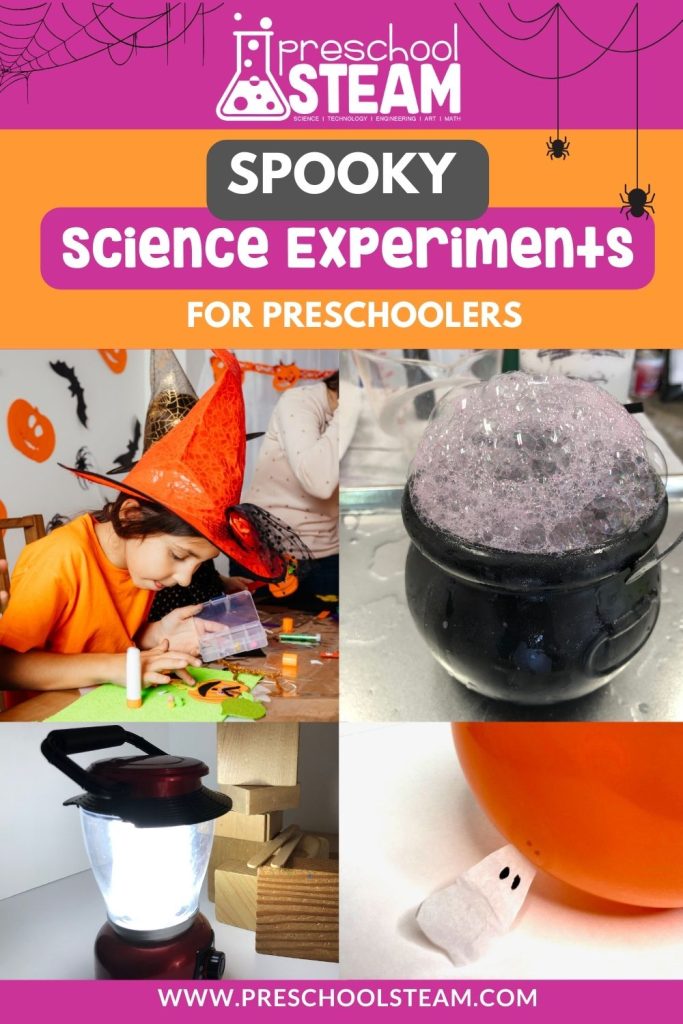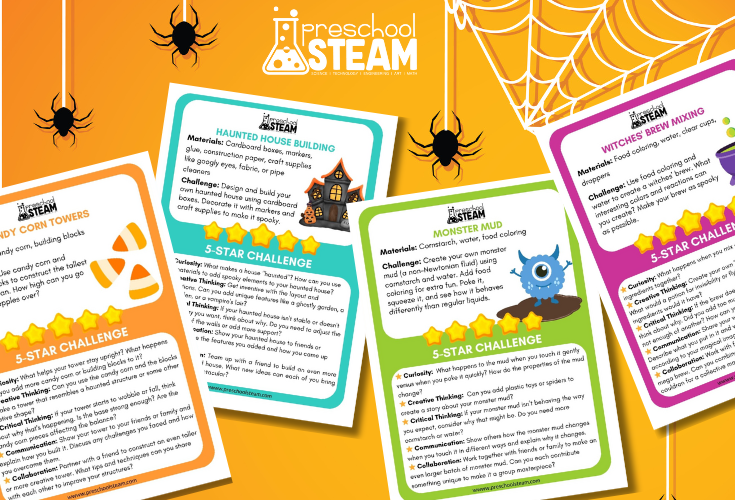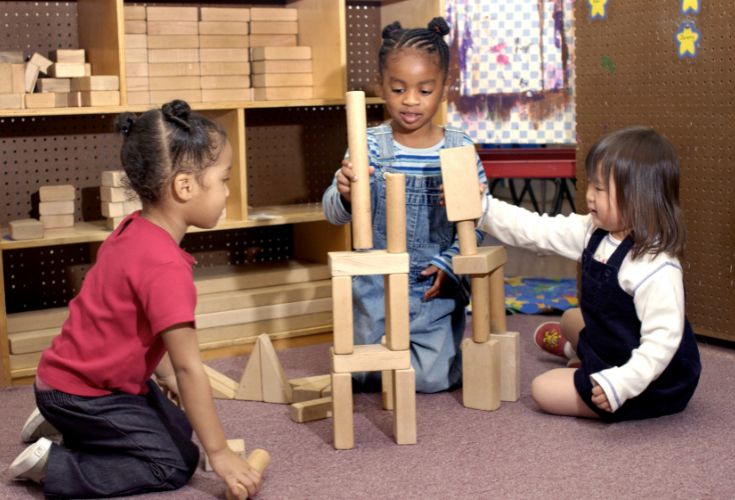Boo! It’s that spooky time of year again when ghosts, goblins, and ghouls come out to play.
But for our young scientists, there’s a lot more than just candy to be excited about. Let’s blend the eeriness of Halloween with the wonder of science, using the 5-Star STEAM approach.
Dive into the world of Spooky Science with these fun experiments that will light up any child’s curiosity, and offer a perfect avenue to develop critical and creative thinking, collaboration, communication, and more!

1. Eerie Ectoplasm
Concept: Polymer Science
You’ll need:
- 1/2 cup of White school glue
- 1/2 cup of Liquid starch (as a slime activator)
- 2 T of Glow-in-the-dark paint
- 15-20 drops of gel food coloring (optional to add color to the slime)
Steps:
- Mix the white school glue with the glow-in-the-dark paint.
- Gradually add the liquid starch, stirring continuously until you achieve a slimy consistency.
- Charge the slime under a light source, then turn off the lights to see it glow eerily!
5-Star STEAM Connection:
- Curiosity: Why does the slime glow in the dark?
- Creative Thinking: Can you create patterns or spooky messages with your glowing slime?
- Critical Thinking: How would changing the ingredients or the amount of glow-in-the-dark paint affect the glow?
- Communication: Share the science behind the glow of the ectoplasm with someone who hasn’t seen it.
- Collaboration: Join forces with a friend to make different colors of glowing slime and see how they look when mixed together.
2. Dancing Spaghetti Worms
Concept: Chemical Reactions
You’ll need:
- 1 cup of water
- 1/2 cup of vinegar
- Dry spaghetti
- 2 t Baking soda
- A clear glass or container
Steps:
- Put the water and baking soda into the glass. Stir until the baking soda is dissolved.
- Break the dry spaghetti into small pieces and place them in a container. Watch what happens.
- Slowly pour in the vinegar and watch the spaghetti worms begin to dance! Add more vinegar when the reaction starts to slow down.
5-Star STEAM Connection:
- Curiosity: Why do the spaghetti pieces move when vinegar is poured?
- Creative Thinking: Can you use different shapes or lengths of spaghetti and see if they dance differently?
- Critical Thinking: What might happen if you change the amount of vinegar or baking soda?
- Communication: Describe the dancing motion of the spaghetti to someone who hasn’t seen the experiment.
- Collaboration: Team up with a friend or sibling. Can you both predict which pieces will dance the fastest or rise the highest?
3. Haunted Shadows
Concept: Light and Shadows
You’ll need:
- Flashlight or a lantern
- Halloween-themed cutouts (bats, witches, etc.)
- A blank wall or a screen
Steps:
- In a dark room, place the cutouts in front of the light source.
- Adjust the distance to make the shadows larger or smaller on the wall.
5-Star STEAM Connection:
Curiosity: How do the shapes and sizes of shadows change as you move the light or cutout?
Creative Thinking: Can you create a spooky story using just the shadows you’ve made?
Critical Thinking: What determines the sharpness or blurriness of a shadow?
Communication: Share with someone the science behind why the shadows appear on the wall.
Collaboration: Work with a partner to create a shadow puppet show with a Halloween theme.
4. Bubbling Witch’s Brew
Concept: Chemical Reactions & Gas Formation
You’ll need:
- A clear container or cauldron
- Baking soda
- Glitter and food coloring (for fun!)
- Vinegar
Steps:
- In the container, add a good amount of baking soda, some glitter, and food coloring.
- Pour in the vinegar and watch the brew bubble and fizz!
5-Star STEAM Connection:
Curiosity: Why does the brew bubble and fizz when vinegar is added?
Creative Thinking: Can you create a spooky backstory for why this witch’s brew behaves this way?
Critical Thinking: How would changing the ingredients alter the reaction?
Communication: Explain to someone the chemical reaction taking place in the witch’s brew.
Collaboration: Invite friends or siblings to make their brews and compare the results. Who has the most bubbly brew?
5. Magic Floating Ghosts
Concept: Static Electricity
You’ll need:
- Balloons
- Tissue paper cutouts of small ghosts
Steps:
- Rub the balloon on your hair or a woolly sweater.
- Slowly bring the balloon close to the tissue ghosts and watch them float up and dance!
5-Star STEAM Connection:
Curiosity: What makes the ghost balloons move? Can you make them dance?
Creative Thinking: Can you make different types of ghost faces? Maybe a happy ghost or a surprised ghost?
Critical Thinking: If your balloon is not moving, what can you do to help it float and dance better?
Communication: Show your ghost balloon to someone and tell them how you made it dance.
Collaboration: Get together with a friend or sibling and see if you can make your ghost balloons dance together. What happens when they meet in the air?
Halloween is not just about treats; it’s a treat for the mind too! With these spooky science experiments, children can dive deep into the world of STEAM, while also embracing the spirit of the season.
Remember, every little discovery, question, or excited exclamation is a step closer to a lifelong love for learning. Happy Spooky Science experimenting!
Want more Halloween quick and easy challenges?
Check out our Halloween 5-Star Challenge Pack!


Leave a Reply